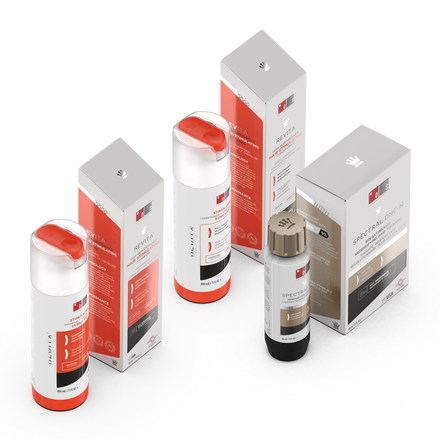Dihydrotestosterone, or DHT, is a sex hormone derived from testosterone. It helps stimulate male characteristic development. An enzyme called 5a-reductase plays a key role in catalyzing DHT formation from testosterone in certain body tissues. Contrary to popular belief, DHT is present in both men and women. While this hormone plays an important role in growth and male development, too much of it can cause hair loss.
How Can I Reduce DHT In My Scalp?
Posted on by Pablo Apartin
What’s the Link Between DHT and Male Pattern Baldness?
Male pattern balding is one of the most common causes of hair loss in men as they age. It’s also referred to as androgenic alopecia. Although women can also experience this type of hair loss, they’re less likely to than men. It’s estimated that approximately 50 million men in the United States have androgenic alopecia, while only about 30 million women have it.
Male pattern baldness is a pattern of hair loss that typically begins on the top and front of the head. It causes the tell-tale visible bald spot that can be so difficult to hide with typical hairstyles. In females with female pattern baldness, thinning usually happens on the crown and top of the head. This often appears as a widening of the front hairline. DHT and excess testosterone play a roll in both types of hair loss. In fact, men who take testosterone supplements are more likely to experience baldness than men who don’t take such supplements.
What Causes Excess DHT?
The pituitary gland and hypothalamus help control testosterone production. There are two primary reasons for excess DHT: increased testosterone levels and increased 5-alpha reductase activity. Nearly 10% of all testosterone produced each day by an adult converts to dihydrotestosterone. The amount of DHT in your body on a day-to-day basis depends largely on the amount of testosterone your body produces. As testosterone levels increase, so do levels of DHT. The same is true for 5-alpha reductase. As it increases, DHT increases as well.
There are two main types of 5-alpha reductase. The first type is found in the sebaceous glands of the skin. It’s the most prominent type. The second type is found in the genitourinary tract and in the hair follicles. It is the type most responsible for DHT-related hair loss.
What Are the Symptoms of Excess DHT?
Symptoms of excess DHT include:
- Excessive sweating
- Acne
- Increased facial and body hair
- Decreased hair around the crown and at the temples
- Sleep apnea
- Increased risk of high blood pressure
- Aggression
- High red blood cell count
Symptoms of high DHT can differ between men and women. For example, women with high DHT are more likely to experience increased acne and unwanted facial hair. Men with excess DHT are more likely to experience excess sweating and aggression. Both genders are likely to experience hair loss on the head as a result of too much DHT production.
Is DHT Important?
Despite its negative effects when it’s produced in excess, DHT is a very important hormone. When it’s properly balanced with other hormones in the body, it plays an essential role in physical development and maturation. You don’t want to get rid of this hormone completely, but if it’s out of balance you may want to take steps to bring it back into balance so you don’t experience its negative effects.
How Can I Reduce DHT in My Scalp?
If you have telltale signs if excess DHT, there may be things you can do to reduce it and bring your hormones back into proper balance. You could take 5-alpha reductase blockers, which help to prevent testosterone from converting into DHT. DHT blockers also interact with the way the DHT receptors signal downstream. There are various DHT blockers that have been approved by the FDA. They are effective, but may come with side effects, including sexual dysfunction in males.
There are natural DHT blockers you can try as well. They include:
- Lycopene
- Green tea
- Fenugreek
- Saw palmetto
- Pumpkin seed oil
- Soy
- Stinging nettle
- Caffeine
- Tea tree oil
- Lavender
- Pygeum
Natural DHT blockers may help you bring the amount of DHT in your body down to more balanced levels. If you want to take the most effective approach, talk to your doctor about how you can safely manage DHT in your body.
What Can I Do if I Already Have Hair Loss?
If you’re already experiencing hair loss from too much DHT, taking a DHT blocker can help prevent further hair loss, but it probably won’t help you regrow your hair. Fortunately, there are other solutions that can help you regrow thick, healthy hair. They include: topical treatments, supplements and shampoos and conditioners. Look for products that contain the following hair-stimulating ingredients:
- Nanoxidil®
- Adenosine
- Retinol
- Caffeine
- Lecithin
- Lysophosphatidic acid
- Myristoyl pentapeptide
- TriCopper peptides
- Azelaic acid
- Taurine
- Niacinamide
- Procyandin B2
This is just a small sampling of the many ingredients that can help regrow your hair if you’ve already lost some due to excess DHT. Remember, it’s equally important to treat the underlying cause of your hair loss if you want to experience the best results from hair-stimulating products.
How Can I Find the Right Products for My Hair?
With such a wide variety of hair growth products available to purchase, how can you find the one that’s right for you? DS Laboratories has created a convenient hair assessment quiz that makes the task of finding the perfect product much easier. To get started, simply fill out the form by answering a few simple, personalized questions. When you finish, you’ll be given one or more product recommendations that will help you meet your hair regrowth goals.










